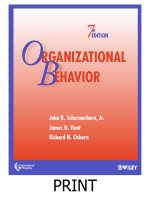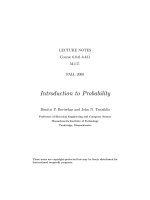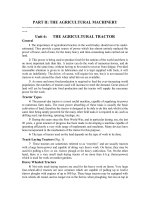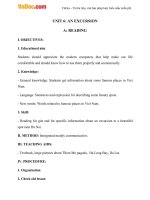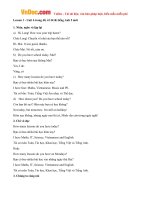Organizational behavior lecture notes, unit 6 OB
Bạn đang xem bản rút gọn của tài liệu. Xem và tải ngay bản đầy đủ của tài liệu tại đây (762.92 KB, 8 trang )
Lecture notes, Unit 6 OB
Explain
Explain
Motivation is the process that accounts for an individual’s intensity, direction, and
persistence of effort toward the attainment of a goal. Intensity is concerned with how hard
a person tries. This is the element most of us focus on when we discuss the topic of
motivation. However, unless effort is channeled in a direction that benefits the
organization, high intensity is no guarantee of favorable job-performance outcomes.
Quality of effort, therefore, is just as important as intensity of effort. Finally, persistence
(how long a person can maintain effort) is important. A motivated person stays with a
task long enough to achieve his or her goal.
1
According to Abraham Maslow, within every human being, the following hierarchy of
needs exists. The first three are deficiency needs because they must be satisfied if the
individual is to be healthy and secure. The last two are growth needs because they are
related to the development and achievement of one’s potential. As each of these needs
becomes substantially satisfied, the next higher need becomes dominant.
1.
Physiological. Hunger, thirst, shelter, sex, and other survival needs.
2.
Safety. Security, stability, and protection from physical or emotional
harm.
3.
Social. Social interaction, affection, companionship, and friendship.
4.
Esteem. Self-respect, autonomy, achievement, status, recognition, and
attention.
5.
Self-actualization. Growth, self-fulfillment, and achieving one’s potential.
Douglas McGregor said that managers hold one of two sets of assumptions about human
nature: either Theory X or Theory Y.
2
Seeing people as irresponsible and lazy, managers who follow Theory X assume the
following:
1.
2.
Employees inherently dislike work and will try to avoid it.
Since employees dislike work, they must be coerced, controlled, or
threatened to achieve goals.
3.
Employees avoid responsibilities and seek formal direction, if possible.
4.
Most workers place security above all other work-related factors and will display
little ambition.
Since they see people as responsible and conscientious, managers who follow Theory Y
assume the following:
1.
2.
3.
4.
Employees can view work as being as natural as rest or play.
When committed to their objectives, people will exercise self-direction and
self-control
The average person can learn to accept, even seek, responsibility.
Many workers besides managers have innovative decision-making skills.
No hard evidence confirms that either set of assumptions is universally true. It is more
likely that the assumptions of Theory X or Theory Y may or may not be appropriate,
depending on the situation at hand.
Frederick Herzberg asked workers to describe situations in which they felt either good or
bad about their jobs. His findings are called motivation-hygiene theory. Herzberg asserted
that intrinsic factors are related to job satisfaction whereas extrinsic factors are associated
with dissatisfaction. So, he called company policy, supervision, interpersonal relations,
working conditions, and salary hygiene factors. When these factors are adequate, people
will not be dissatisfied; however, they will not be satisfied either. He believed that
achievement, recognition, the work itself, growth, and responsibility are motivational
because people find them intrinsically rewarding.
3
intrinsic
–adjective
1. belonging to a thing by its very nature: the intrinsic value of a gold ring.
2. Anatomy. (of certain muscles, nerves, etc.) belonging to or lying within a given part.
[Origin: 1480–90; < ML intrinsecus inward (adj.), L (adv.), equiv. to intrin- (int(e)r-, as in
INTERIOR + -im adv. suffix) + secus beside, deriv. of sequī to follow]
—Synonyms 1. native, innate, natural, true, real. See ESSENTIAL.
—Antonyms 1. extrinsic.
extrinsic
–adjective
1. not essential or inherent; not a basic part or quality; extraneous: facts that are extrinsic
to the matter under discussion.
2. being outside a thing; outward or external; operating or coming from without: extrinsic
influences.
Another theory
4
David McClelland proposed that three learned needs motivate behavior. The need for
achievement (nAch) is the need to excel, to achieve in relation to a set of standards, to
succeed. The need for power (nPow) is the need to make others behave in ways in which
they would not have behaved otherwise. The need for affiliation (nAff) is the desire for
interpersonal relationships. He believed that these needs are acquired from the culture of
a society.
Discuss
Discuss
5
Workers compare their job inputs and outcomes with others. There are three possible
perceptions: inequity due to being under-rewarded, equity, or inequity due to being overrewarded. Equity theory proposes that inequity creates tension, and that this tension can
cause an employee to seek fairness. There are four referents that an employee can use: (1)
Self-inside: an employee’s experiences in a different position inside the organization. (2)
Self-outside: an employee’s experiences in a position outside of the organization. (3)
Other-inside: an employee’s perception of persons inside the organization. (4) Otheroutside: an employee’s perception of persons outside of the organization.
Workers who perceive an inequity will react in one of the six following ways: change
inputs, change outcomes, distort perceptions of self, distort perceptions of others, choose
a different referent, or leave the field.
Equity theory establishes four propositions relating to inequitable pay. First, given
payment by time, over-rewarded employees will produce more than those paid equitably.
Second, given payment by quantity of production, over-rewarded employees will produce
fewer, but higher quality units, than will equitably paid employees. Third, given payment
by time, under-rewarded employees will produce less or poorer quality of output. Fourth,
given payment by quantity of production, under-rewarded employees will produce a large
number of low-quality units in comparison with equitably paid employees.
Explain
6
Expectancy theory argues that an employee will be motivated to produce more when he
or she believes that the effort will lead to a good performance appraisal; that a good
appraisal will lead to organizational rewards; and that the rewards will satisfy the
employee’s personal goals. This theory focuses on three relationships.
1.
The effort-performance relationship is the probability perceived by the
individual that exerting a given amount of effort will lead to performance.
2.
The performance-rewards relationship is the degree to which an individual
believes that performing at a particular level will lead to the attainment of a
desired outcome.
3.
The rewards-personal goals relationship is the degree to which the rewards
of an organization satisfy an individual’s personal goals or needs and the
attractiveness of those rewards.
Explain
Explain
7
Explain
8
